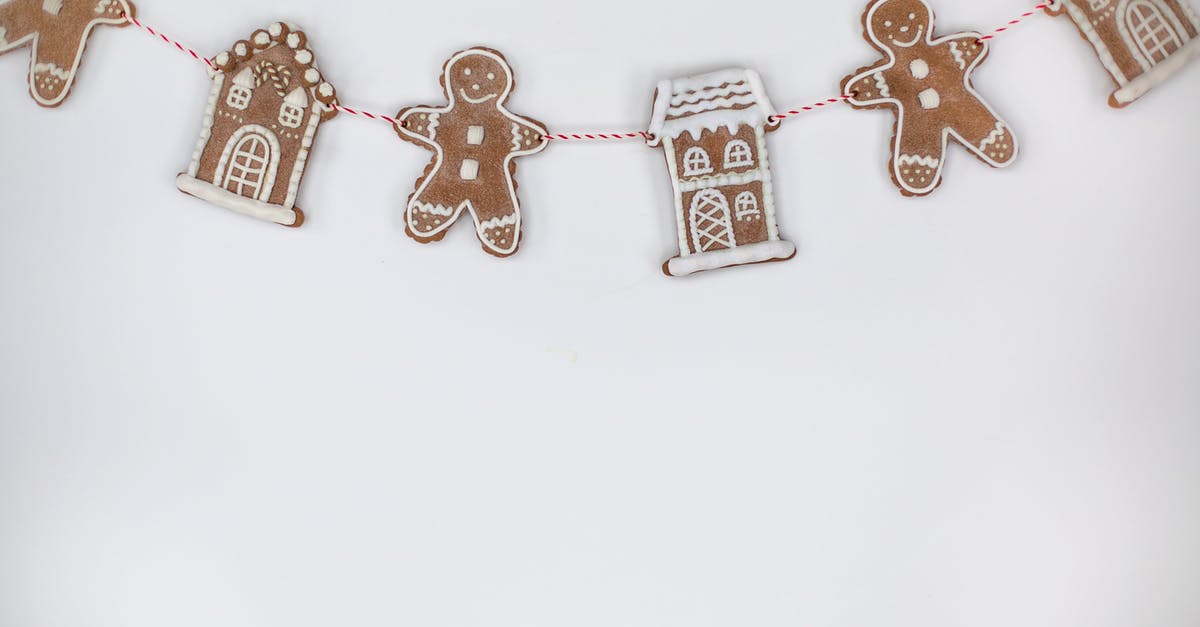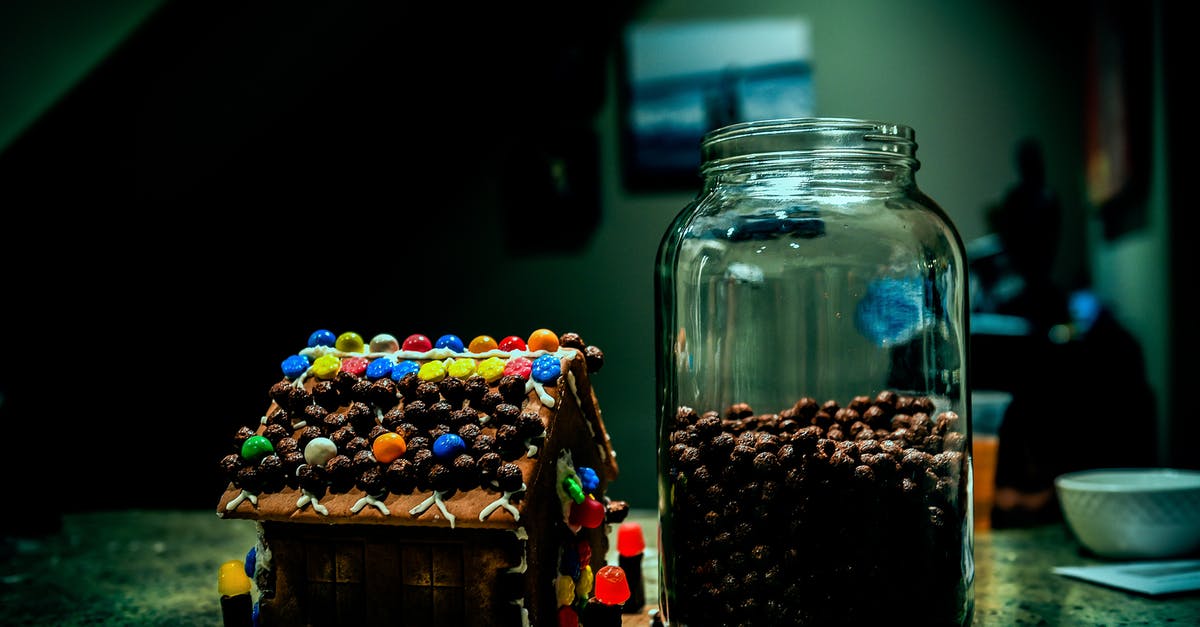Advice for gingerbread houses?

I'm considering entering a gingerbread house contest with my mom this year. I might've done a few as a kid, but I've only done one before in my adult life, more than 10 years ago, and I remember having problems with the amount of spread of the parts.
Does anyone have any advice? are there any tricks to keep parts from spreading as much, or should I be baking the parts, then cutting them? (or par-baking, cut while still soft, then finish baking to firm everything up?)
Should I bake the parts well in advance to let them dry out / stale up so they're stiffer before assembly, or do I want a little bit of flex when I'm assembling so I don't accidentally crack them while working?
Also, recommendations on the best thickness of wall sections to use (especially based on the height I'm dealing with, as I assume I'd want them thicker the higher I'm going) would be great, too.
Best Answer
I make gingerbread houses every year. Walls should be approximately 1/4 inch thick. I have found that cutting the pieces first to work best. Yes there is some spread, but when they come out of the oven, I replace the stencil and trim up any spread (for the straight outside edges, a pizza cutter works well). I know it sounds redundant, but sometimes I don't cut quick enough, or I am distracted by the phone, or any other number of things, if I only cut after baking. With the items pre-cut, if I get distracted, I at least have a usable part. Granted I may have to shave any spread very gently with a microplane or the edge of a knife, but that is just what works for me.
I also will roll the dough out on parchment paper, cut and remove the excess, then slide the whole thing onto a pan for baking. This way, you don't get any "stretch" of your pieces. I have several square cookie cutters that I will use to cut out the windows and such. I make the windows rectangular by using the cookie cutter and cutting a square then moving it and cutting another half square. This is helpful because when the gingerbread comes out of the oven, you don't have to spend a lot of time with a knife trimming the inside of all the windows... you just punch any spread out with the cookie cutter.
As Sobachatina mentioned, melted sugar makes beautiful windows. I however, will lay the walls on a silicone mat and pour the sugar directly into the window holes. No need to "glue."
I'd hate for you to make a gingerbread house with the "wrong" icing. You want an icing that will dry rock hard, like cement. For this you will want to use "Royal Icing."
For larger houses, use canned goods to hold the walls in place while the icing dries. The house should be built at least one day before you start decorating, to be sure it has set up really good.
Pictures about "Advice for gingerbread houses?"



Quick Answer about "Advice for gingerbread houses?"
- Step 1: Get organized. Check out what comes with your kit. ...
- Step 2: Assemble the house. Follow the directions on the package for building the house. ...
- Step 3: Let the icing dry. Don't start decorating right away—your house needs time to dry. ...
- Step 4: Decorate!
What is the trick to building a gingerbread house?
It's the best option for projects like gingerbread houses since, unlike buttercream frosting, royal icing will harden once dry. It's the key to keeping your gingerbread house from falling down.What is the best ingredient to keep gingerbread houses from falling?
Pick a solid base for your gingerbread house - either a flat cookie sheet, or a thick, sturdy piece of cardboard. If you want, line the base with aluminum foil or wax paper. Mortar the sides of the house with royal icing: Pipe a thick line of icing along a short end of one of the side pieces.What is a good base for a gingerbread house?
An easy trick is to decorate the sides before you assemble the house itself. The roof area is easier to decorate after assembly, but it definitely helps to decorate the sides first.Expert tips on how to make a stunning gingerbread house
More answers regarding advice for gingerbread houses?
Answer 2
With our recipe we cut the shapes before baking. It puffs a little but doesn't spread. Like justkt, I roll it about 1/4 inch.
Besides wall thickness, how high you can go really depends on your recipe and the local humidity. When living in humid climates we have sometimes had to paint the inside of the baked walls with icing to give them more rigidity. That was, however, for a much larger than normal house and a much more humid than normal climate.
A fun trick that I did last year and was well worth my time: I melted some sugar and poured it into a pool to spread on buttered foil. Then I glued (with icing of course) the sugar window panes inside all my cut out windows. I installed a lamp inside the house. It made for a very impressive display. The just barely golden sugar panes produced a very warm glow.
Answer 3
When I last did a gingerbread house 2 years ago we pre-cut to our pattern, put everything on parchment paper, baked the gingerbread, and trimmed it while it was still warm due to spreading (way more than we expected). If we'd let it cool any more it probably would've been crumbly.
The recipe we used had the gingerbread firmer than cracker dough - much to firm to actually enjoy eating - and it worked out perfectly for assembly.
Our walls were probably about 1/4 inch thick after rising in the oven, but it was thinner before cooking, and the resulting house was a bit under a foot tall.
Answer 4
Cut out the doors and windows before baking.
Use rock (candy cane) for the corner struts.
If you can get hold of the video, Heston Blumenthal made a large gingerbread house. There are some great tips in there.
Answer 5
I cut while warm. At least for structural pieces. This gives nice square, flat corners. Indeed, the edges created like this have air bubbles along the edge which provide good purchase for the icing that will hold pieces together.
You need to dry all your pieces as well. This is typically done by leaving them in the oven at a real low temperature for a couple hours. Once dry, a thick piece of gingerbread feels as hard as plywood (mmm, plywood!)
Royal icing is also hard as cement. Between that and dry gingerbread, you can build at least to the size of a large dollhouse.
Oh, and have your design done before hand. Make your slabs according to the sizes you plan on, don't try making a house from a set recipe size like some directions might say. This always leads to one piece somewhere that doesn't get enough dough.
Oh, and don't let the kids eat it while you're building.
Sources: Stack Exchange - This article follows the attribution requirements of Stack Exchange and is licensed under CC BY-SA 3.0.
Images: Jill Wellington, Rachel Xiao, EKATERINA BOLOVTSOVA, EKATERINA BOLOVTSOVA
